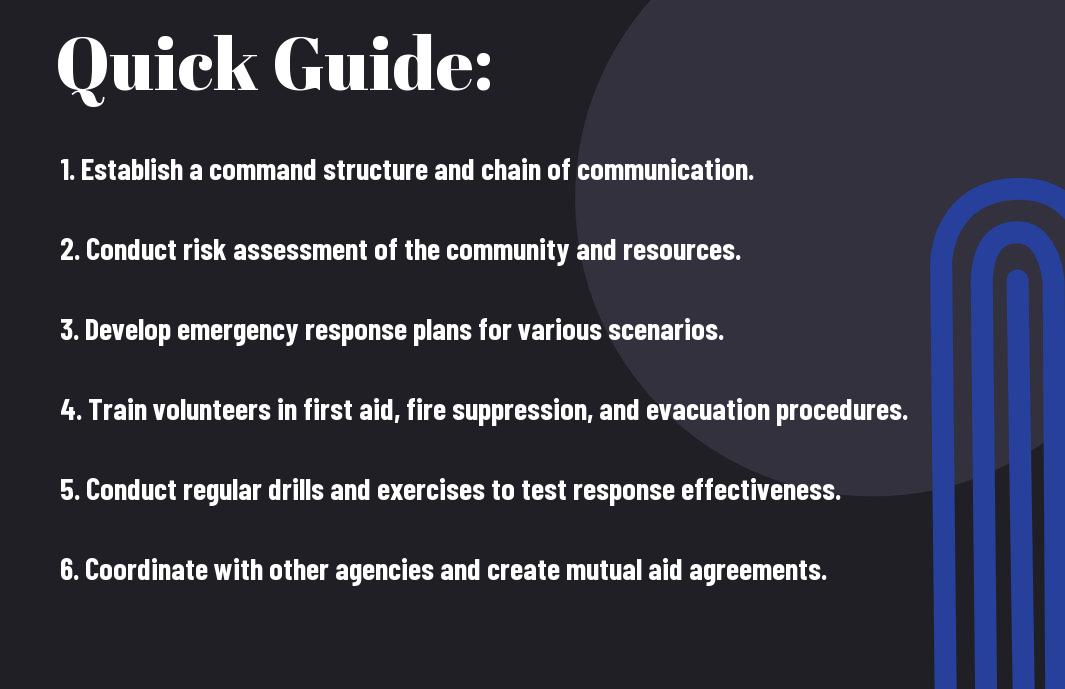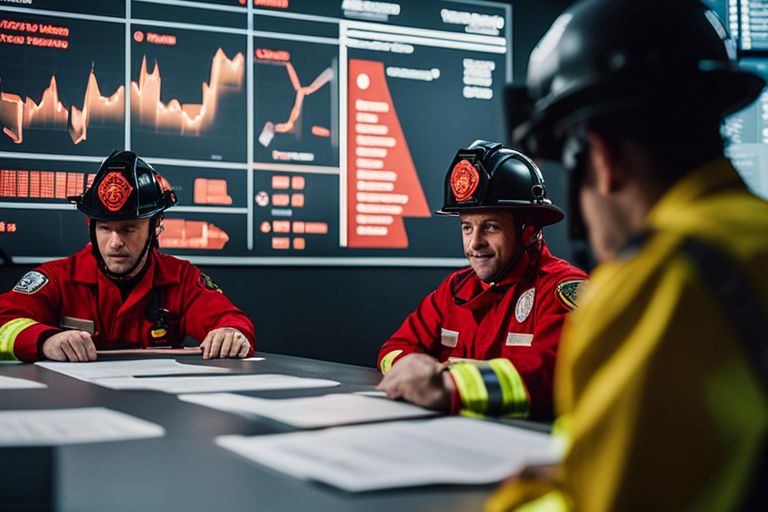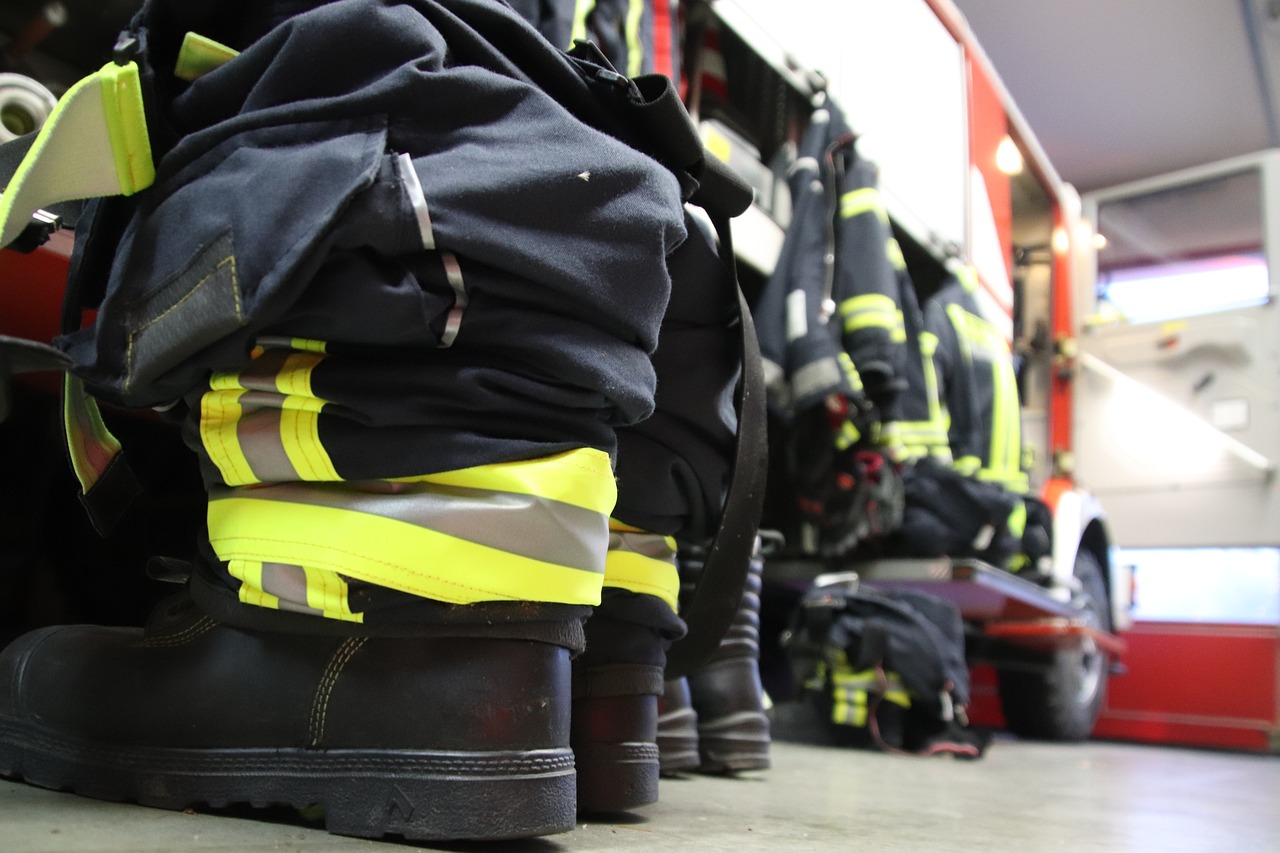Many volunteer fire departments face unique challenges when it comes to emergency response planning. In this comprehensive guide, you will learn the vital steps to create a solid emergency response plan that addresses the most critical aspects of keeping your community safe. From fire prevention strategies to incident command procedures, this guide will equip you with the knowledge and tools needed to effectively respond to emergencies as a volunteer firefighter.
Understanding Emergency Response Planning
To effectively respond to emergencies, you must have a solid understanding of emergency response planning. This involves developing strategies and procedures to handle different types of emergencies that your volunteer fire department may encounter.
Types of Emergency Response Plans
- Fire Emergency Response Plan: This plan outlines procedures for responding to fires, including evacuation routes, equipment use, and communication protocols.
- Natural Disaster Response Plan: This plan covers how your department will respond to natural disasters like hurricanes, earthquakes, or floods, including coordination with other agencies and disaster recovery efforts.
- Hazmat Emergency Response Plan: This plan details how to handle hazardous materials incidents, including containment, decontamination, and evacuation procedures.
- Medical Emergency Response Plan: This plan outlines how your department will respond to medical emergencies, including providing basic first aid and coordinating with EMS services.
- Training and Exercise Plan: This plan focuses on ongoing training and drills to ensure your team is prepared to respond effectively to any emergency situation.
Though each type of emergency response plan is unique, they all play a critical role in ensuring your volunteer fire department is prepared to handle emergencies effectively.
Importance of Emergency Response Planning for Volunteer Fire Departments
While you may hope to never have to respond to a major emergency, it is important to be prepared for any situation that may arise. Emergency response planning is crucial for volunteer fire departments because it helps you save lives, protect property, and ensure the safety of your community.
Planning for emergencies also allows you to identify potential risks, establish clear communication channels, and coordinate effectively with other emergency services. By having well-thought-out emergency response plans in place, you can minimize chaos and confusion during emergencies, ultimately leading to a more successful outcome.
Factors to Consider in Emergency Response Planning
There’s a lot to take into account when creating an effective emergency response plan for your volunteer fire department. Here are some key factors to consider:
- Identifying Risks and Hazards: Some of the most crucial aspects of emergency response planning involve identifying the risks and hazards that your community may face. This includes natural disasters, industrial accidents, transportation incidents, and more. By understanding these potential threats, you can better prepare your department to respond effectively. To learn more about creating a comprehensive emergency response plan, check out FEMA’s Planning Guides.
Identifying Risks and Hazards
Some of the most crucial aspects of emergency response planning involve identifying the risks and hazards that your community may face. This includes natural disasters, industrial accidents, transportation incidents, and more. By understanding these potential threats, you can better prepare your department to respond effectively.
Assessing Resources and Capabilities
You should also assess your department’s resources and capabilities. This includes evaluating your equipment, training, personnel, and mutual aid agreements. By understanding what resources you have available, you can better allocate them in an emergency situation. Any gaps in resources can then be addressed through training, partnerships, or additional equipment acquisitions.
Understanding Local Regulations and Standards
Understanding the local regulations and standards that impact emergency response operations is crucial. This includes compliance requirements, reporting procedures, and coordination with other agencies. By staying up-to-date on these regulations, you can ensure that your department operates safely and effectively within the legal framework.
Step-by-Step Guide to Creating an Emergency Response Plan
Many volunteer fire departments lack a comprehensive emergency response plan, which is crucial for effectively handling various situations. Creating a well-thought-out plan can significantly improve your department’s readiness and response to emergencies of all kinds. In this guide, we will walk you through the vital steps to develop an emergency response plan tailored to your volunteer fire department’s needs.
| Establishing a Planning Team | Conducting a Risk Assessment |
Establishing a Planning TeamEstablishing a planning team is the first step in developing an effective emergency response plan. Your team should consist of individuals with diverse backgrounds and expertise, including firefighters, medical personnel, and community leaders. Assign roles and responsibilities to each team member to ensure a coordinated effort. |
Conducting a Risk AssessmentIf you want to prepare for emergencies effectively, conducting a risk assessment is crucial. Identify potential hazards in your response area, such as natural disasters, industrial incidents, or transportation accidents. Assess the likelihood and potential impact of these hazards to prioritize your planning efforts. |
Plan: Involve local experts and officials in the risk assessment process to gain a better understanding of potential threats and vulnerabilities in your community.
Developing Emergency Response Procedures
An emergency response plan is only as strong as the procedures it outlines. Establish standardized procedures for various types of emergencies, including fire incidents, medical emergencies, hazardous material spills, and search and rescue operations. Ensure that your procedures are clear, concise, and easy to follow under stressful conditions.
An: Regularly review and update your emergency response procedures based on lessons learned from drills, incidents, and changes in your response area’s risk profile.
Identifying Communication Strategies
Risk communication is a critical component of effective emergency response. Identify primary and alternative communication methods to ensure seamless information flow during emergencies. Establish protocols for internal and external communication, including coordination with other emergency services and agencies.
To: Test your communication strategies regularly through drills and exercises to identify potential gaps or weaknesses in your department’s communication capabilities.
Establishing Training and Drills
Response readiness requires ongoing training and practice. Develop a comprehensive training program that covers basic firefighting skills, emergency medical procedures, incident command systems, and specialized rescue techniques. Conduct regular drills and exercises to test your department’s response capabilities and identify areas for improvement.
For instance: Simulate high-stress scenarios during drills to assess the effectiveness of your emergency response procedures and communication strategies under pressure.
Effective Communication in Emergency Response Planning
Once again, effective communication plays a crucial role in emergency response planning for volunteer fire departments. In the chaos of an emergency situation, clear and concise communication can make all the difference between a successful operation and a potential disaster.
Tips for Clear and Concise Communication
- Use clear and simple language to avoid any confusion.
- Provide specific details and follow-up instructions to ensure everyone is on the same page.
This approach will help you coordinate efforts effectively and ensure a swift response from all team members involved. Recall, in high-stress situations, clarity is key.
Communication Strategies for Emergency Situations
Strategies for effective communication during emergencies include establishing designated communication channels, such as radio frequencies or messaging platforms, to relay critical information efficiently. Sharing situational awareness updates and identifying potential hazards in real-time can help everyone make informed decisions quickly.
Understanding the importance of prompt and accurate communication is imperative in emergency response scenarios. By prioritizing effective communication strategies, you can enhance the overall coordination and response capabilities of your volunteer fire department.
The Role of Technology in Emergency Communication
Assuming the responsibility of leveraging technology for communication purposes can significantly improve your emergency response planning. From utilizing public alert systems to employing GPS tracking devices for personnel, technology offers various tools to enhance communication and coordination.
Emergency situations can be unpredictable and challenging, but with the right technology at your disposal, you can enhance the efficiency and effectiveness of your volunteer fire department’s emergency response efforts.
Training and Drills for Emergency Response
Now, let’s look into the vital elements of training and drills for volunteer fire departments to ensure preparedness for any emergency situation.
Pros and Cons of Different Training Methods
Some of the most common training methods for volunteer fire departments include hands-on drills, online courses, classroom sessions, and simulation exercises. Here is a breakdown of the pros and cons of each method:
| Training Method | Pros and Cons |
| Hands-on Drills | Pros: Real-life experience, improved skills. Cons: Time-consuming, limited scenarios. |
| Online Courses | Pros: Flexibility, accessibility. Cons: Lack of hands-on experience, potential for distraction. |
| Classroom Sessions | Pros: Interactive learning, group discussion. Cons: Lack of practical application, limited to theoretical knowledge. |
| Simulation Exercises | Pros: Realistic scenarios, team coordination. Cons: Costly, resource-intensive. |
Developing a Training Schedule
If you want to ensure that your volunteer fire department is well-prepared for emergencies, it’s crucial to develop a comprehensive training schedule. By setting aside dedicated time for training sessions regularly, you can improve the skills and readiness of your team.
If you are unsure where to start, consider conducting a training needs assessment to identify the areas that need improvement. This will help you tailor your training schedule to address specific skills or knowledge gaps within your department.
Conducting Regular Drills and Exercises
Training is not a one-time event – it requires regular practice and reinforcement. By conducting regular drills and exercises, you can simulate emergency scenarios and test your team’s response in a controlled environment. This hands-on experience will help build confidence and improve efficiency during real-life emergencies.
You should incorporate a variety of scenarios into your drills to ensure that your team is well-rounded in their skills and can adapt to different situations. Include scenarios such as structure fires, vehicle accidents, hazardous material incidents, and search and rescue missions to cover a wide range of emergencies.
Implementing and Maintaining an Emergency Response Plan
Keep Community Engagement and Volunteer Management for Emergency Response at the forefront when implementing and maintaining your emergency response plan. This will ensure that you have the support and resources needed to carry out the plan effectively.
Factors to Consider in Plan Implementation
- When implementing your emergency response plan, training your volunteer firefighters is crucial to ensure they understand their roles and responsibilities during an emergency.
- Regular drills and exercises should be conducted to test the effectiveness of the plan and identify any areas that need improvement.
- Collaboration with local authorities and other emergency response agencies is crucial to ensure that everyone is on the same page during an emergency situation.
After implementing your plan, make sure to solicit feedback from your volunteers and incorporate any necessary changes to improve the plan’s efficacy.
Ongoing Plan Review and Revision
Any effective emergency response plan requires regular review and revision to stay current and address any changing circumstances in your community. Make sure to schedule regular meetings to discuss any updates or changes that need to be made to the plan.
Integrating the Plan into Daily Operations
You should ensure that the emergency response plan is seamlessly integrated into your daily operations to optimize coordination and response times. Plan regular training sessions and drills to keep your volunteer firefighters prepared for any situation that may arise.

Conclusion
Following this ultimate guide to emergency response planning for volunteer fire departments should help you create a comprehensive and effective strategy to handle emergencies in your community. By incorporating the steps outlined in this guide, you can ensure that your department is well-prepared to respond to a wide range of incidents quickly and effectively.
Recall, emergency response planning is crucial for the safety and well-being of your community members. By prioritizing preparedness and training, you can make a significant impact in emergency situations and help save lives. Thank you for your dedication and commitment to serving your community as a volunteer firefighter.



